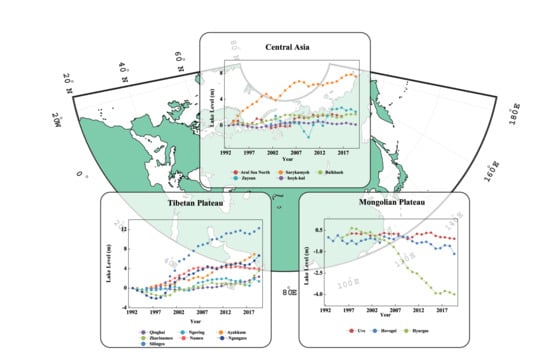Changing Pattern of Water Level Trends in Eurasian Endorheic Lakes as a Response to the Recent Climate Variability
Abstract
:1. Introduction
2. Materials and Methods
2.1. Study Sites
2.2. Lake Water Level Dataset from Satellite Altimetry Data
2.3. Meteorological Dataset
2.4. Data Integration
2.5. Trend Analysis
2.6. Cumulative Anomaly Analysis
2.7. Change Point Detection
3. Results
3.1. Spatiotemporal Variations of Lake Level
3.2. Climate Effects on the Lake Levels
3.3. Regime Shifts in Precipitation and Temperature
4. Discussion
5. Conclusions
Supplementary Materials
Author Contributions
Funding
Institutional Review Board Statement
Informed Consent Statement
Data Availability Statement
Acknowledgments
Conflicts of Interest
References
- Dudgeon, D.; Arthington, A.H.; Gessner, M.O.; Kawabata, Z.-I.; Knowler, D.J.; Lévêque, C.; Naiman, R.J.; Prieur-Richard, A.-H.; Soto, D.; Stiassny, M.L.J.; et al. Freshwater biodiversity: Importance, threats, status and conservation challenges. Biol. Rev. 2006, 81, 163–182. [Google Scholar] [CrossRef] [PubMed]
- Lioubimtseva, E. Impact of Climate Change on the Aral Sea and Its Basin. In The Aral Sea; Springer: Berlin/Heidelberg, Germany, 2014; Volume 10178, pp. 405–427. [Google Scholar]
- Shinneman, A.L.C.; Almendinger, J.E.; Umbanhowar, C.E.; Edlund, M.B.; Nergui, S. Paleolimnologic Evidence for Recent Eutrophication in the Valley of the Great Lakes (Mongolia). Ecosystems 2009, 12, 944–960. [Google Scholar] [CrossRef]
- Yakutin, M.V.; Andrievskii, V.S.; Lhagvasuren, C. Change in the main components of the destruction link of biological cycle in the series of plain soils of the Great Lakes Depression in West Mongolia. Contemp. Probl. Ecol. 2010, 3, 305–311. [Google Scholar] [CrossRef]
- Imentai, A.; Thevs, N.; Schmidt, S.; Nurtazin, S.; Salmurzauli, R. Vegetation, fauna, and biodiversity of the Ile Delta and southern Lake Balkhash—A review. J. Great Lakes Res. 2015, 41, 688–696. [Google Scholar] [CrossRef]
- Song, C.; Huang, B.; Ke, L.; Richards, K.S. Seasonal and abrupt changes in the water level of closed lakes on the Tibetan Plateau and implications for climate impacts. J. Hydrol. 2014, 514, 131–144. [Google Scholar] [CrossRef]
- Lei, Y.; Yao, T.; Bird, B.W.; Yang, K.; Zhai, J.; Sheng, Y. Coherent lake growth on the central Tibetan Plateau since the 1970s: Characterization and attribution. J. Hydrol. 2013, 483, 61–67. [Google Scholar] [CrossRef]
- Li, B.; Zhang, J.; Yu, Z.; Liang, Z.; Chen, L.; Acharya, K. Climate change driven water budget dynamics of a Tibetan inland lake. Glob. Planet. Chang. 2017, 150, 70–80. [Google Scholar] [CrossRef]
- Zhang, G.; Yao, T.; Xie, H.; Kang, S.; Lei, Y. Increased mass over the Tibetan Plateau: From lakes or glaciers? Geophys. Res. Lett. 2013, 40, 2125–2130. [Google Scholar] [CrossRef]
- Hu, Z.; Zhang, C.; Hu, Q.; Tian, H. Temperature Changes in Central Asia from 1979 to 2011 Based on Multiple Datasets. J. Clim. 2013, 27, 1143–1167. [Google Scholar] [CrossRef]
- Chen, F.; Huang, W.; Jin, L.; Chen, J.; Wang, J. Spatiotemporal precipitation variations in the arid Central Asia in the context of global warming. Sci. China Earth Sci. 2011, 54, 1812–1821. [Google Scholar] [CrossRef]
- Yang, K.; Wu, H.; Qin, J.; Lin, C.; Tang, W.; Chen, Y. Recent climate changes over the Tibetan Plateau and their impacts on energy and water cycle: A review. Glob. Planet. Chang. 2014, 112, 79–91. [Google Scholar] [CrossRef]
- Oki, T.; Kanae, S. Global Hydrological Cycles and World Water Resources. Science 2006, 313, 1068. [Google Scholar] [CrossRef] [Green Version]
- Zhao, Y.; Liao, J.J.; Shen, G.Z.; Zhang, X.L. Monitoring lake level changes by altimetry in the arid region of Central Asia. IOP Conf. Ser. Earth Environ. Sci. 2017, 74, 012004. [Google Scholar] [CrossRef] [Green Version]
- Zhang, G.; Yao, T.; Piao, S.; Bolch, T.; Xie, H.; Chen, D.; Gao, Y.; O’Reilly, C.M.; Shum, C.K.; Yang, K.; et al. Extensive and drastically different alpine lake changes on Asia’s high plateaus during the past four decades. Geophys. Res. Lett. 2017, 44, 252–260. [Google Scholar] [CrossRef] [Green Version]
- Song, C.; Huang, B.; Ke, L. Heterogeneous change patterns of water level for inland lakes in High Mountain Asia derived from multi-mission satellite altimetry. Hydrol. Process. 2015, 29, 2769–2781. [Google Scholar] [CrossRef]
- Kouraev, A.V.; Kostianoy, A.G.; Lebedev, S.A. Ice cover and sea level of the Aral Sea from satellite altimetry and radiometry (1992–2006). J. Mar. Syst. 2009, 76, 272–286. [Google Scholar] [CrossRef]
- Chen, J.L.; Pekker, T.; Wilson, C.R.; Tapley, B.D.; Kostianoy, A.G.; Cretaux, J.F.; Safarov, E.S. Long-term Caspian Sea level change. Geophys. Res. Lett. 2017, 44, 6993–7001. [Google Scholar] [CrossRef]
- Lioubimtseva, E.; Cole, R. Uncertainties of Climate Change in Arid Environments of Central Asia. Rev. Fish. Sci. 2006, 14, 29–49. [Google Scholar] [CrossRef]
- Zhang, G.; Xie, H.; Kang, S.; Yi, D.; Ackley, S.F. Monitoring lake level changes on the Tibetan Plateau using ICESat altimetry data (2003–2009). Remote Sens. Environ. 2011, 115, 1733–1742. [Google Scholar] [CrossRef]
- Phan, V.H.; Lindenbergh, R.C.; Menenti, M. Geometric dependency of Tibetan lakes on glacial runoff. Hydrol. Earth Syst. Sci. 2013, 17, 4061–4077. [Google Scholar] [CrossRef] [Green Version]
- Lei, Y.; Yao, T.; Yang, K.; Sheng, Y.; Kleinherenbrink, M.; Yi, S.; Bird, B.W.; Zhang, X.; Zhu, L.; Zhang, G. Lake seasonality across the Tibetan Plateau and their varying relationship with regional mass changes and local hydrology. Geophys. Res. Lett. 2017, 44, 892–900. [Google Scholar] [CrossRef] [Green Version]
- Wang, H.; Chu, Y.; Huang, Z.; Hwang, C.; Chao, N. Robust, Long-term Lake Level Change from Multiple Satellite Altimeters in Tibet: Observing the Rapid Rise of Ngangzi Co over a New Wetland. Remote Sens. 2019, 11, 558. [Google Scholar] [CrossRef] [Green Version]
- Held, I.M.; Soden, B.J. Robust Responses of the Hydrological Cycle to Global Warming. J. Clim. 2006, 19, 5686–5699. [Google Scholar] [CrossRef]
- Chou, C.; Chiang, J.C.H.; Lan, C.-W.; Chung, C.-H.; Liao, Y.-C.; Lee, C.-J. Increase in the range between wet and dry season precipitation. Nat. Geosci. 2013, 6, 263–267. [Google Scholar] [CrossRef]
- Hu, Z.; Chen, X.; Chen, D.; Li, J.; Wang, S.; Zhou, Q.; Yin, G.; Guo, M. “Dry gets drier, wet gets wetter”: A case study over the arid regions of central Asia. Int. J. Climatol. 2019, 39, 1072–1091. [Google Scholar] [CrossRef]
- Dilinuer, T.; Yao, J.-Q.; Chen, J.; Mao, W.-Y.; Yang, L.-M.; Yeernaer, H.; Chen, Y.-H. Regional drying and wetting trends over Central Asia based on Köppen climate classification in 1961–2015. Adv. Clim. Chang. Res. 2021, 12, 363–372. [Google Scholar] [CrossRef]
- Tan, Q.; Liu, Y. Spatiotemporal variation and climatic response of water level of major lakes in China, Mongolia, and Russia. Open Geosci. 2020, 12, 1200–1211. [Google Scholar] [CrossRef]
- Yang, X.; Wang, N.; Chen, A.a.; He, J.; Hua, T.; Qie, Y. Changes in area and water volume of the Aral Sea in the arid Central Asia over the period of 1960–2018 and their causes. CATENA 2020, 191, 104566. [Google Scholar] [CrossRef]
- Liu, H.; Chen, Y.; Ye, Z.; Li, Y.; Zhang, Q. Recent Lake Area Changes in Central Asia. Sci. Rep. 2019, 9, 16277. [Google Scholar] [CrossRef] [Green Version]
- Yao, T.; Masson-Delmotte, V.; Gao, J.; Yu, W.; Yang, X.; Risi, C.; Sturm, C.; Werner, M.; Zhao, H.; He, Y.; et al. A review of climatic controls on δ18O in precipitation over the Tibetan Plateau: Observations and simulations. Rev. Geophys. 2013, 51, 525–548. [Google Scholar] [CrossRef]
- Yao, T.; Thompson, L.; Yang, W.; Yu, W.; Gao, Y.; Guo, X.; Yang, X.; Duan, K.; Zhao, H.; Xu, B.; et al. Different glacier status with atmospheric circulations in Tibetan Plateau and surroundings. Nat. Clim. Chang. 2012, 2, 663–667. [Google Scholar] [CrossRef]
- Crétaux, J.F.; Jelinski, W.; Calmant, S.; Kouraev, A.; Vuglinski, V.; Bergé-Nguyen, M.; Gennero, M.C.; Nino, F.; Abarca Del Rio, R.; Cazenave, A.; et al. SOLS: A lake database to monitor in the Near Real Time water level and storage variations from remote sensing data. Adv. Space Res. 2011, 47, 1497–1507. [Google Scholar] [CrossRef]
- Birkett, C.M. The contribution of TOPEX/POSEIDON to the global monitoring of climatically sensitive lakes. J. Geophys. Res. Ocean. 1995, 100, 25179–25204. [Google Scholar] [CrossRef]
- Birkett, C.M.; Beckley, B. Investigating the Performance of the Jason-2/OSTM Radar Altimeter over Lakes and Reservoirs. Mar. Geod. 2010, 33, 204–238. [Google Scholar] [CrossRef]
- Schwatke, C.; Dettmering, D.; Bosch, W.; Seitz, F. DAHITI—An innovative approach for estimating water level time series over inland waters using multi-mission satellite altimetry. Hydrol. Earth Syst. Sci. 2015, 19, 4345–4364. [Google Scholar] [CrossRef] [Green Version]
- Crétaux, J.F.; Abarca-del-Río, R.; Bergé-Nguyen, M.; Arsen, A.; Drolon, V.; Clos, G.; Maisongrande, P. Lake Volume Monitoring from Space. Surv. Geophys. 2016, 37, 269–305. [Google Scholar] [CrossRef] [Green Version]
- Martina, R.; Charon, M.B.; James, C.; Jean-Francois, C. Intercomparison and validation of continental water level products derived from satellite radar altimetry. J. Appl. Remote Sens. 2012, 6, 063614. [Google Scholar] [CrossRef]
- Birkett, C.; Reynolds, C.; Beckley, B.; Doorn, B. From Research to Operations: The USDA Global Reservoir and Lake Monitor. In Coastal Altimetry; Vignudelli, S., Kostianoy, A.G., Cipollini, P., Benveniste, J., Eds.; Springer: Berlin/Heidelberg, Germany, 2011; pp. 19–50. [Google Scholar]
- Becker, A.; Finger, P.; Meyer-Christoffer, A.; Rudolf, B.; Schamm, K.; Schneider, U.; Ziese, M. A description of the global land-surface precipitation data products of the Global Precipitation Climatology Centre with sample applications including centennial (trend) analysis from 1901–present. Earth Syst. Sci. Data 2013, 5, 71–99. [Google Scholar] [CrossRef] [Green Version]
- Schneider, U.; Finger, P.; Meyer-Christoffer, A.; Rustemeier, E.; Ziese, M.; Becker, A. Evaluating the Hydrological Cycle over Land Using the Newly-Corrected Precipitation Climatology from the Global Precipitation Climatology Centre (GPCC). Atmosphere 2017, 8, 52. [Google Scholar] [CrossRef] [Green Version]
- Willmott., C.J.; Matsuurra, K. Terrestrial Precipitation: 1900–2017 Gridded Monthly Time Series (Version 5.01). 2018. Available online: http://climate.geog.udel.edu/~climate/html_pages/download.html (accessed on 13 July 2021).
- Harris, I.; Jones, P.D.; Osborn, T.J.; Lister, D.H. Updated high-resolution grids of monthly climatic observations—The CRU TS3.10 Dataset. Int. J. Climatol. 2014, 34, 623–642. [Google Scholar] [CrossRef] [Green Version]
- Schiemann, R.; Lüthi, D.; Vidale, P.L.; Schär, C. The precipitation climate of Central Asia—Intercomparison of observational and numerical data sources in a remote semiarid region. Int. J. Climatol. 2008, 28, 295–314. [Google Scholar] [CrossRef]
- Sun, Q.; Miao, C.; Duan, Q.; Ashouri, H.; Sorooshian, S.; Hsu, K.-L. A Review of Global Precipitation Data Sets: Data Sources, Estimation, and Intercomparisons. Rev. Geophys. 2018, 56, 79–107. [Google Scholar] [CrossRef] [Green Version]
- Thorndahl, S.; Einfalt, T.; Willems, P.; Nielsen, J.E.; ten Veldhuis, M.C.; Arnbjerg-Nielsen, K.; Rasmussen, M.R.; Molnar, P. Weather radar rainfall data in urban hydrology. Hydrol. Earth Syst. Sci. 2017, 21, 1359–1380. [Google Scholar] [CrossRef] [Green Version]
- Hu, Z.; Zhou, Q.; Chen, X.; Li, J.; Li, Q.; Chen, D.; Liu, W.; Yin, G. Evaluation of three global gridded precipitation data sets in central Asia based on rain gauge observations. Int. J. Climatol. 2018, 38, 3475–3493. [Google Scholar] [CrossRef]
- Hu, Z.; Zhou, Q.; Chen, X.; Qian, C.; Wang, S.; Li, J. Variations and changes of annual precipitation in Central Asia over the last century. Int. J. Climatol. 2017, 37, 157–170. [Google Scholar] [CrossRef]
- Hu, Z.; Hu, Q.; Zhang, C.; Chen, X.; Li, Q. Evaluation of reanalysis, spatially interpolated and satellite remotely sensed precipitation data sets in central Asia. J. Geophys. Res. Atmos. 2016, 121, 5648–5663. [Google Scholar] [CrossRef] [Green Version]
- Pan, M.; Sahoo, A.K.; Troy, T.J.; Vinukollu, R.K.; Sheffield, J.; Wood, E.F. Multisource Estimation of Long-Term Terrestrial Water Budget for Major Global River Basins. J. Clim. 2011, 25, 3191–3206. [Google Scholar] [CrossRef]
- Aires, F. Combining Datasets of Satellite-Retrieved Products. Part I: Methodology and Water Budget Closure. J. Hydrometeorol. 2014, 15, 1677–1691. [Google Scholar] [CrossRef]
- Kendall, M.G. Rank Correlation Methods; Griffin: London, UK, 1948. [Google Scholar]
- Mann, H.B. Nonparametric Tests against Trend. Econometrica 1945, 13, 245–259. [Google Scholar] [CrossRef]
- Hamed, K.H. Trend detection in hydrologic data: The Mann–Kendall trend test under the scaling hypothesis. J. Hydrol. 2008, 349, 350–363. [Google Scholar] [CrossRef]
- Von Storch, H. Misuses of statistical analysis in climate research. In Analysis of Climate Variability; Springer: Berlin/Heidelberg, Germany, 1999; pp. 11–26. [Google Scholar]
- Yue, S.; Pilon, P.; Phinney, B.; Cavadias, G. The influence of autocorrelation on the ability to detect trend in hydrological series. Hydrol. Process. 2002, 16, 1807–1829. [Google Scholar] [CrossRef]
- Tan, X.; Gan, T.Y.; Shao, D. Effects of persistence and large-scale climate anomalies on trends and change points in extreme precipitation of Canada. J. Hydrol. 2017, 550, 453–465. [Google Scholar] [CrossRef]
- Gocic, M.; Trajkovic, S. Analysis of changes in meteorological variables using Mann-Kendall and Sen’s slope estimator statistical tests in Serbia. Glob. Planet. Chang. 2013, 100, 172–182. [Google Scholar] [CrossRef]
- Dadaser-Celik, F.; Cengiz, E. Wind speed trends over Turkey from 1975 to 2006. Int. J. Climatol. 2013, 34, 1913–1927. [Google Scholar] [CrossRef]
- Sen, P.K. Estimates of the regression coefficient based on Kendall’s tau. J. Am. Stat. Assoc. 1968, 63, 1379–1389. [Google Scholar] [CrossRef]
- Lozowski, E.P.; Charlton, R.B.; Nguyen, C.D.; Wilson, J.D. The Use of Cumulative Monthly Mean Temperature Anomalies in the Analysis of Local Interannual Climate Variability. J. Clim. 1989, 2, 1059–1068. [Google Scholar] [CrossRef] [Green Version]
- Yang, Y.; Long, D.; Guan, H.; Scanlon, B.R.; Simmons, C.T.; Jiang, L.; Xu, X. GRACE satellite observed hydrological controls on interannual and seasonal variability in surface greenness over mainland Australia. J. Geophys. Res. Biogeosci. 2014, 119, 2245–2260. [Google Scholar] [CrossRef]
- Wu, L.; Wang, S.; Bai, X.; Luo, W.; Tian, Y.; Zeng, C.; Luo, G.; He, S. Quantitative assessment of the impacts of climate change and human activities on runoff change in a typical karst watershed, SW China. Sci. Total Environ. 2017, 601–602, 1449–1465. [Google Scholar] [CrossRef] [PubMed]
- Pettitt, A.N. A Non-Parametric Approach to the Change-Point Problem. J. R. Stat. Soc. Ser. C (Appl. Stat.) 1979, 28, 126–135. [Google Scholar] [CrossRef]
- Kim, C.; Suh, M.-S.; Hong, K.-O. Bayesian Changepoint Analysis of the Annual Maximum of Daily and Subdaily Precipitation over South Korea. J. Clim. 2009, 22, 6741–6757. [Google Scholar] [CrossRef]
- Ruggieri, E. A Bayesian approach to detecting change points in climatic records. Int. J. Climatol. 2013, 33, 520–528. [Google Scholar] [CrossRef]
- Yang, Z.; Zhou, Y.; Wenninger, J.; Uhlenbrook, S. The causes of flow regime shifts in the semi-arid Hailiutu River, Northwest China. Hydrol. Earth Syst. Sci. 2012, 16, 87–103. [Google Scholar] [CrossRef] [Green Version]
- Izhitskiy, A.S.; Zavialov, P.O.; Sapozhnikov, P.V.; Kirillin, G.B.; Grossart, H.P.; Kalinina, O.Y.; Zalota, A.K.; Goncharenko, I.V.; Kurbaniyazov, A.K. Present state of the Aral Sea: Diverging physical and biological characteristics of the residual basins. Sci. Rep. 2016, 6, 23906. [Google Scholar] [CrossRef] [Green Version]
- Zavialov, P. Physical Oceanography of the Dying Aral Sea; Springer: Berlin/Heidelberg, Germany, 2007. [Google Scholar] [CrossRef]
- Shnitnikov, A. Water balance variability of lakes Aral, Balkhash, Issyk-Kul and Chany. In Hydrology of Lakes; Bartholomew Press: Dorking, Surrey, 1973; pp. 130–140. [Google Scholar]
- Klerkx, J.; Imanackunov, B. Lake Issyk-Kul: Its Natural Environment; Springer: Berlin/Heidelberg, Germany, 2002. [Google Scholar]
- Kezer, K.; Matsuyama, H. Decrease of river runoff in the Lake Balkhash basin in Central Asia. Hydrol. Process. 2006, 20, 1407–1423. [Google Scholar] [CrossRef]
- Dorfman, B.F. Zaysan-the Only Surviving Cretaceous Lake-May be Lost. Procedia Environ. Sci. 2011, 10, 1376–1382. [Google Scholar] [CrossRef] [Green Version]
- Orlovsky, L.; Matsrafi, O.; Orlovsky, N.; Kouznetsov, M. Sarykamysh Lake: Collector of Drainage Water–The Past, the Present, and the Future. In The Turkmen Lake Altyn Asyr and Water Resources in Turkmenistan; Springer: Berlin/Heidelberg, Germany, 2012; pp. 107–140. [Google Scholar]
- Bai, J.; Chen, X.; Yang, L.; Fang, H. Monitoring variations of inland lakes in the arid region of Central Asia. Front. Earth Sci. 2012, 6, 147–156. [Google Scholar] [CrossRef]
- Propastin, P. Patterns of Lake Balkhash water level changes and their climatic correlates during 1992–2010 period. Lakes Reserv. Sci. Policy Manag. Sustain. Use 2012, 17, 161–169. [Google Scholar] [CrossRef]
- Lioubimtseva, E.; Henebry, G.M. Climate and environmental change in arid Central Asia: Impacts, vulnerability, and adaptations. J. Arid Environ. 2009, 73, 963–977. [Google Scholar] [CrossRef]
- Lioubimtseva, E. A multi-scale assessment of human vulnerability to climate change in the Aral Sea basin. Environ. Earth Sci. 2015, 73, 719–729. [Google Scholar] [CrossRef]
- Zhao, L.; Simon Wang, S.Y.; Meyer, J. Interdecadal Climate Variations Controlling the Water Level of Lake Qinghai over the Tibetan Plateau. J. Hydrometeorol. 2017, 18, 3013–3025. [Google Scholar] [CrossRef]
- Biskop, S.; Maussion, F.; Krause, P.; Fink, M. Differences in the water-balance components of four lakes in the southern-central Tibetan Plateau. Hydrol. Earth Syst. Sci. 2016, 20, 209–225. [Google Scholar] [CrossRef] [Green Version]
- Zhou, J.; Wang, L.; Zhang, Y.; Guo, Y.; Li, X.; Liu, W. Exploring the water storage changes in the largest lake (Selin Co) over the Tibetan Plateau during 2003–2012 from a basin-wide hydrological modeling. Water Resour. Res. 2015, 51, 8060–8086. [Google Scholar] [CrossRef] [Green Version]
- Yao, T.; Thompson, L.G.; Mosbrugger, V.; Zhang, F.; Ma, Y.; Luo, T.; Xu, B.; Yang, X.; Joswiak, D.R.; Wang, W.; et al. Third Pole Environment (TPE). Environ. Dev. 2012, 3, 52–64. [Google Scholar] [CrossRef]
- Zhang, G.; Yao, T.; Shum, C.K.; Yi, S.; Yang, K.; Xie, H.; Feng, W.; Bolch, T.; Wang, L.; Behrangi, A.; et al. Lake volume and groundwater storage variations in Tibetan Plateau’s endorheic basin. Geophys. Res. Lett. 2017, 44, 5550–5560. [Google Scholar] [CrossRef]
- Tong, K.; Su, F.; Xu, B. Quantifying the contribution of glacier meltwater in the expansion of the largest lake in Tibet. J. Geophys. Res. Atmos. 2016, 121, 11, 111–158, 173. [Google Scholar] [CrossRef]
- Qiao, B.; Zhu, L. Difference and cause analysis of water storage changes for glacier-fed and non-glacier-fed lakes on the Tibetan Plateau. Sci. Total Environ. 2019, 693, 133399. [Google Scholar] [CrossRef] [PubMed]
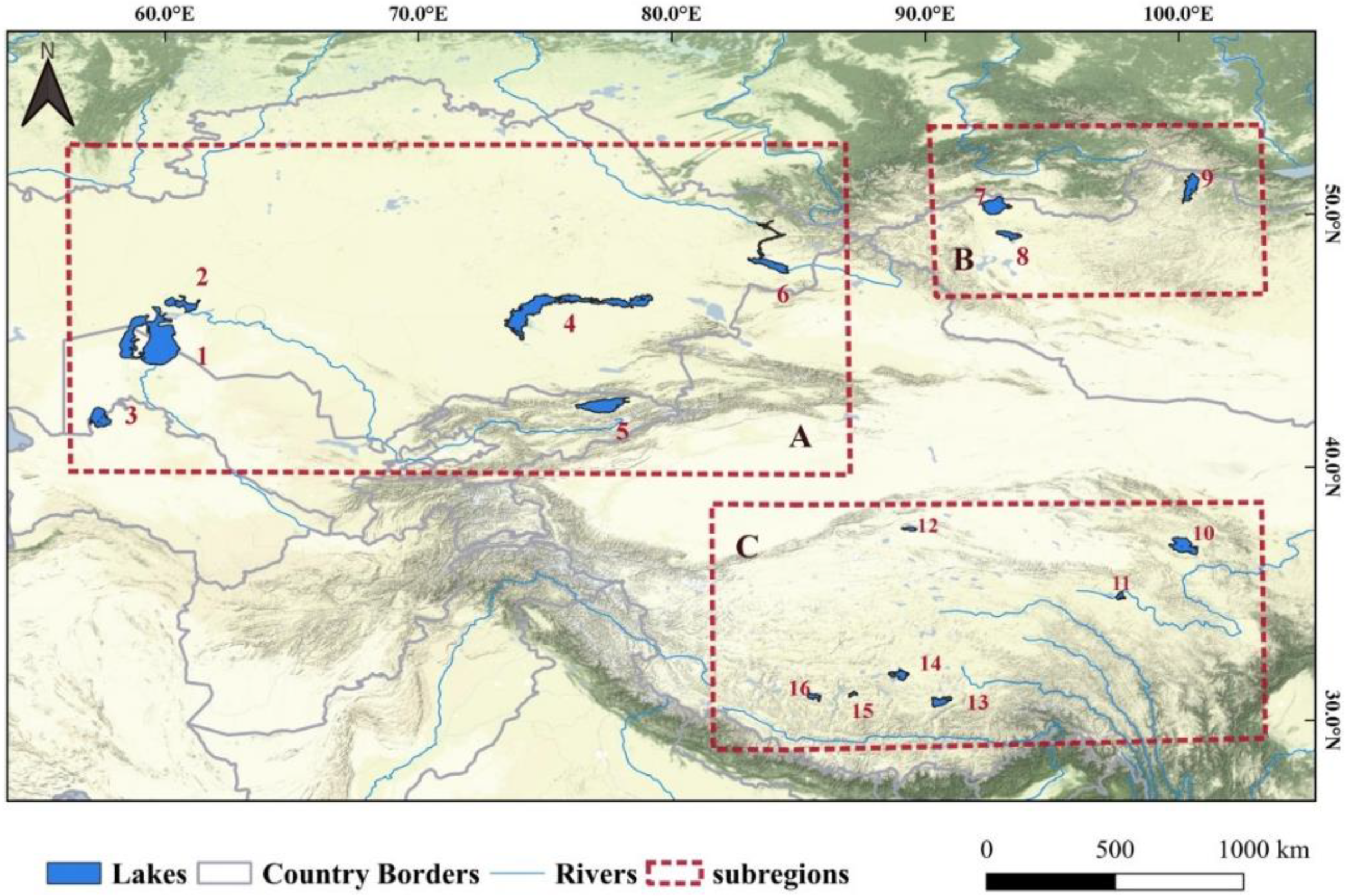

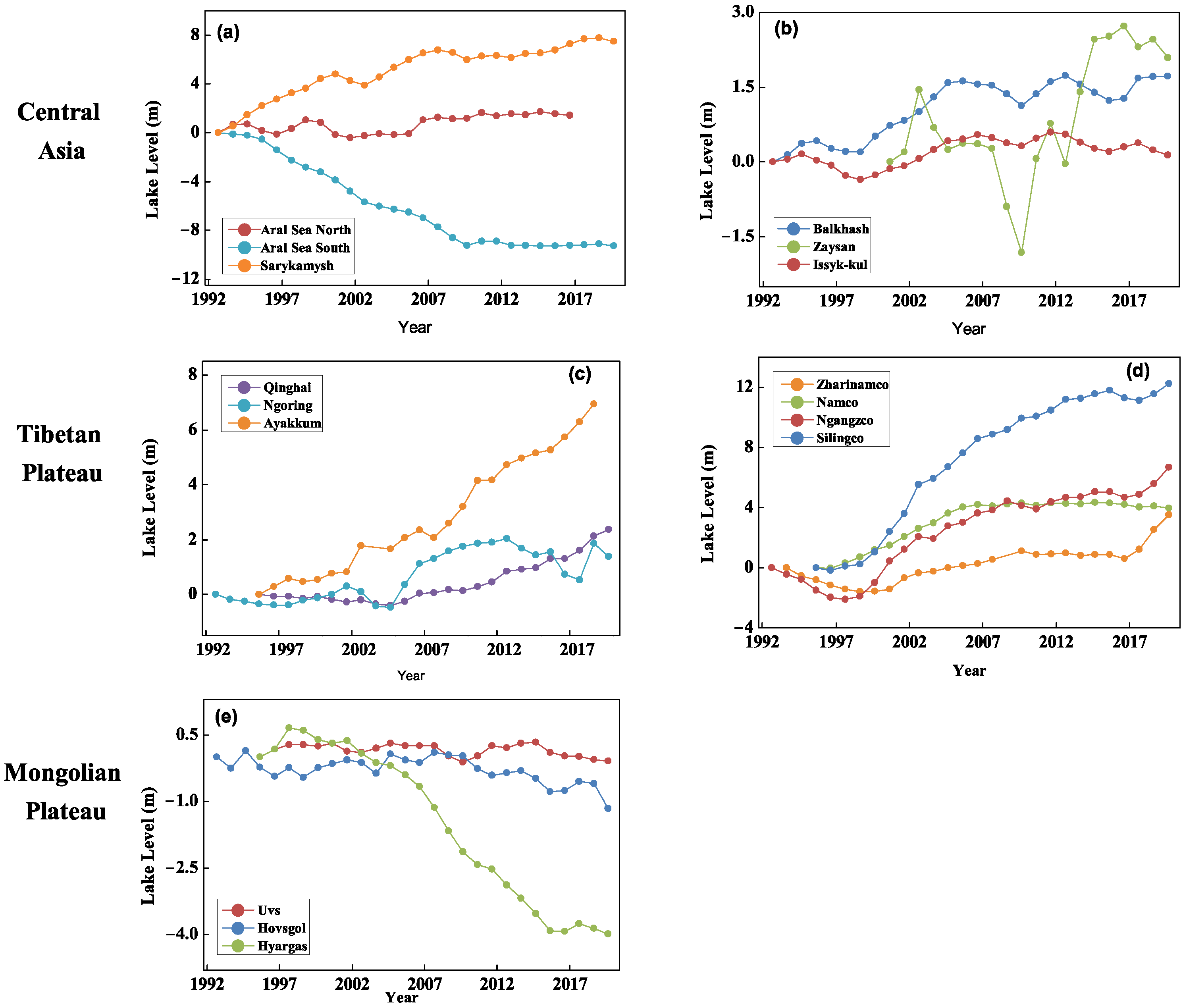
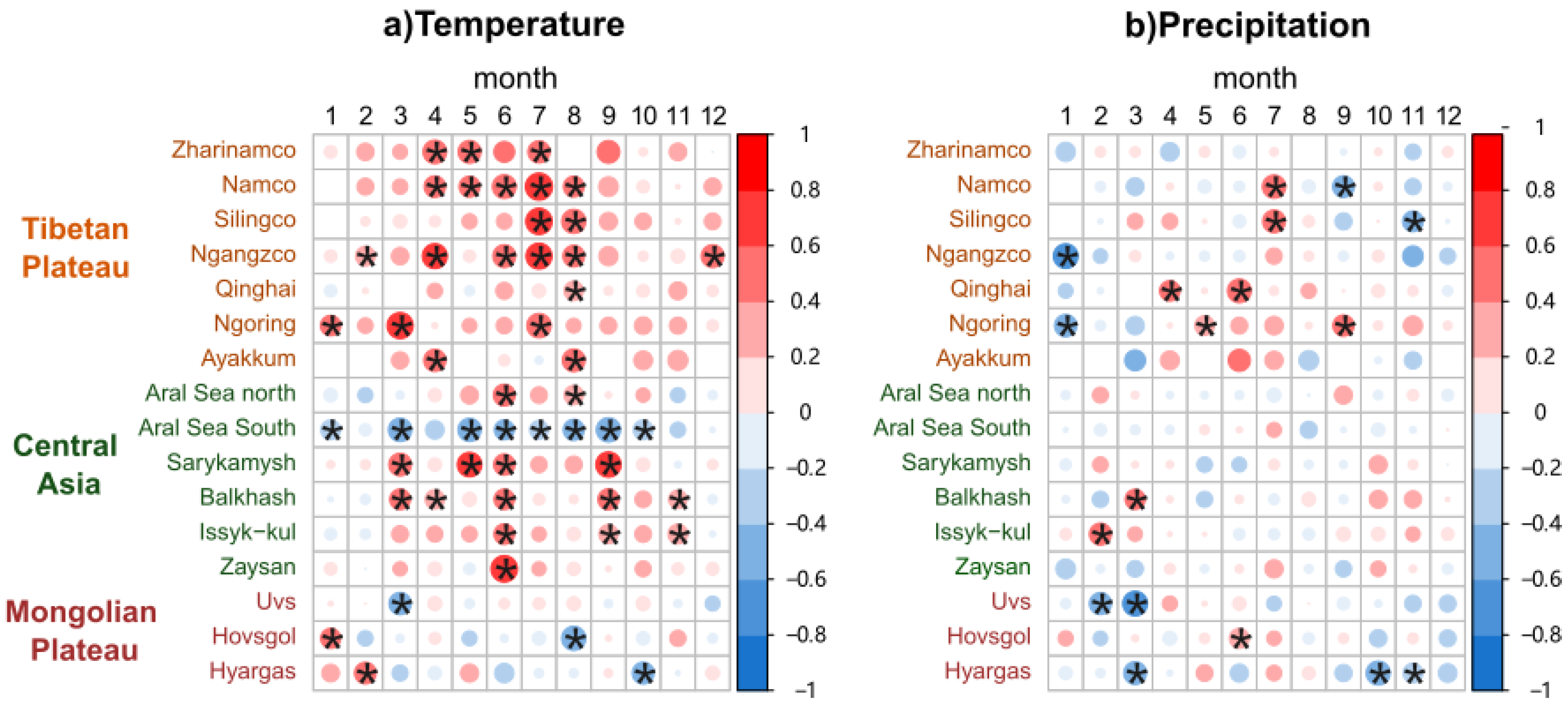

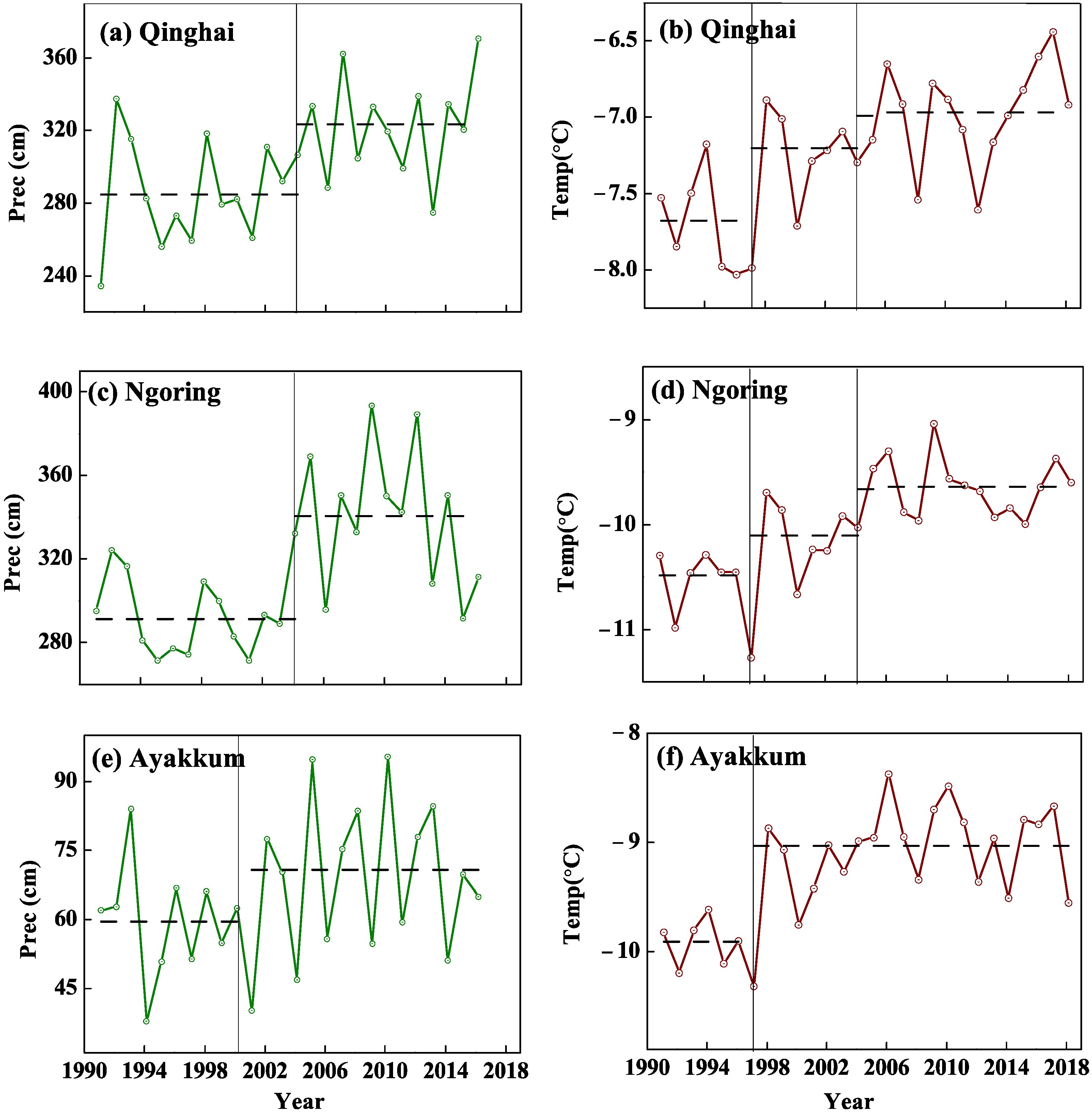
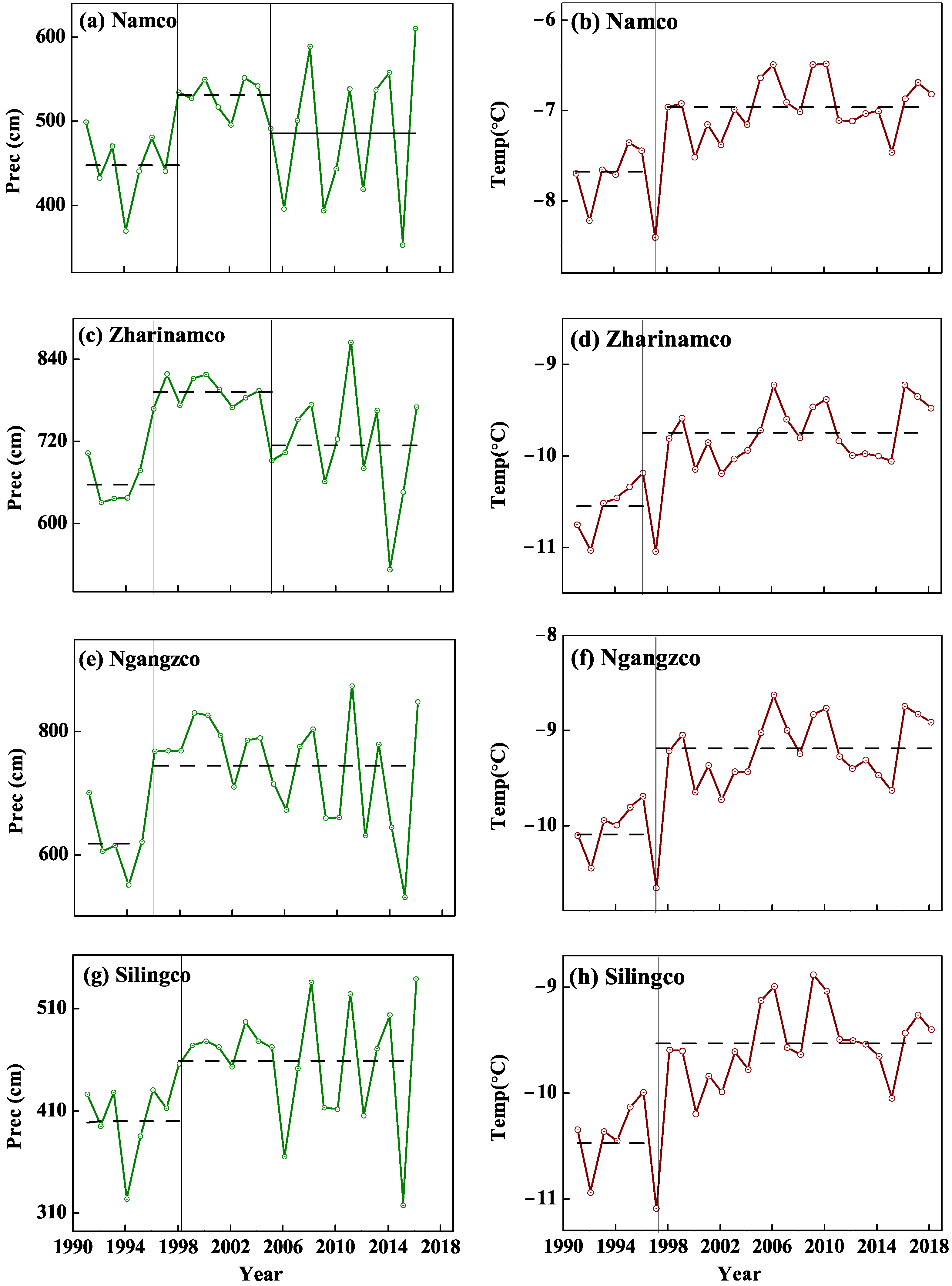
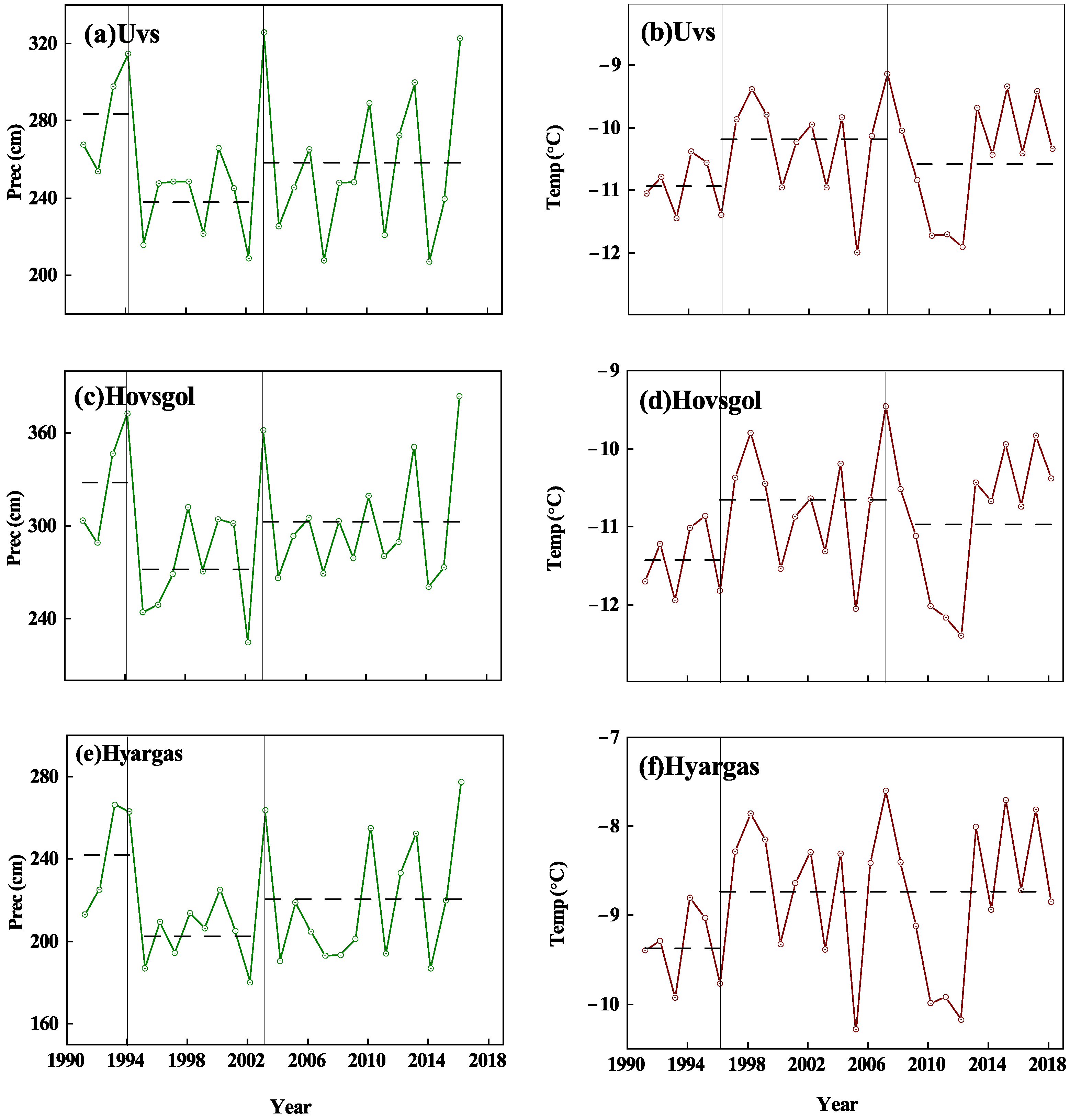
| Region | Lake Name | Latitude (° N) | Longitude (° E) | Area (km2) | Elevation (m) | Country |
|---|---|---|---|---|---|---|
| Central Asia | Aral Sea | 46.4 | 60.6 | 18,999 | 42 | Kazakhstan Uzbekistan |
| Sarykamysh | 41.9 | 57.4 | 3852 | 5 | Uzbekistan | |
| Balkhash | 46.1 | 74.2 | 16,683 | 349 | Kazakhstan | |
| Issyk-Kul | 42.4 | 77.3 | 6148 | 1619 | Kyrgyzstan | |
| Zaysan | 48.1 | 83.9 | 2913 | 379 | Kazakhstan | |
| Tibetan Plateau | Qinghai | 37 | 100.1 | 4312 | 3260 | China |
| Ngoring | 34.9 | 97.7 | 621 | 4292 | China | |
| Ayakkum | 37.5 | 89.4 | 856 | 4161 | China | |
| Silingco | 31.80 | 88.99 | 2222 | 4550 | China | |
| Namco | 30.74 | 90.60 | 2021 | 4730 | China | |
| Zharinamco | 30.92 | 85.61 | 1001 | 4292 | China | |
| Ngangzco | 31.10 | 87.10 | 390 | 4680 | China | |
| Mongolian Plateau | Uvs | 50.3 | 92.7 | 3421 | 759 | Mongolia |
| Hyargas | 49.1 | 93.1 | 1362 | 1028 | Mongolia | |
| Hovsgol | 55.1 | 100.5 | 2741 | 1645 | Mongolia |
| Lake Name | Trend (cm/yr) | Pearson Correlation Coefficient | |||
|---|---|---|---|---|---|
| Hydroweb GREALM | GREALM DAHITI | Hydroweb DAHITI | |||
| Central Asia | Balkhash | 5.762 | 0.996 | 0.930 | 1.000 |
| Issyk-Kul | 1.698 | 0.994 | 0.981 | 1.000 | |
| Zaysan | 6.067 | 0.865 | 0.982 | 0.968 | |
| Aral Sea South | −37.824 | 0.995 | 1.000 | 0.997 | |
| Aral Sea North | 5.862 | 0.987 | 0.989 | 0.996 | |
| Sarykamysh | 21.151 | 0.988 | 0.997 | 1.000 | |
| Tibetan Plateau | Qinghai | 10.461 | 0.996 | ||
| Ngoring | 8.651 | 0.983 | |||
| Ayakkum | 32.631 | 0.991 | |||
| Zharinamco | 14.763 | 0.980 | 0.742 | 0.953 | |
| Ngangzco | 3.012 | 0.996 | 0.962 | 0.959 | |
| Namco | 13.821 | 0.940 | |||
| Silingco | 52.451 | 0.999 | |||
| Monglian Plateau | Uvs | −0.6172 | 0.936 | ||
| Hovsgol | −1.192 | 0.586 | 0.377 | 0.497 | |
| Hyargas | −36.143 | 0.999 | |||
| Lake Names | Glacier Area/Lake Area | Lake Level Anomaly | Precipitation Anomaly | Temperature Anomaly | |
|---|---|---|---|---|---|
| Central Asia | Balkhash | Increase(+), then fluctuate | Fluctuated | Slight increase (+) | |
| Zaysan | Decrease (−), then increased (+) | Decrease (−), then increased (+) | Increase (+) | ||
| Issyk-Kul | 0.08 | Increase (+) | Increase (+) | Increase (+) | |
| Sarykmysh | Increase (+) | Fluctuated | Increase (+) | ||
| Aral Sea | Fluctuated | Fluctuated decrease (−) | Increase (+) | ||
| Tibetan Plateau (south) | Zharinamco | 0.15 | Increase (+), | Increase (+), then fluctuated | Increase (+) |
| Namco | 0.1 | Increase (+), | Increase (+), then fluctuated | Increase (+) | |
| Silingco | 0.13 | Increase (+) | Increase (+) | Increase (+) | |
| Ngangzco | 0.02 | Increase (+) | Increase (+) | Increase (+) | |
| Tibetan Plateau (north) | Qinghai | 0.01 | Increase (+) | Increase (+) | Increase (+) |
| Ngoring | Increase (+) | Increase (+) | Increase (+) | ||
| Ayakkum | 0.55 | Increase (+) | Increase (+) | Increase (+) | |
| Mongolian Plateau | Uvs | Decrease (−) | Decrease (−) | Fluctuated increase (+) | |
| Hyargas | Decrease (−) | Decrease (−) | Fluctuated increase (+) | ||
| Hovsgol | Decrease (−) | Decrease (−) | Fluctuated increase (+) |
| Region | Lake Names | Precipitation | Temperature | ||
|---|---|---|---|---|---|
| The Timing of Change Point | Mean Value of Each Regime (cm) | The Timing of Change Point | Mean Value of Each Regime | ||
| Tibetan Plateau | Qinghai | 2004 | 284,714 323,244 | 1997 2004 | −7.677 |
| −7.202 | |||||
| −6.990 | |||||
| Ngoring | 2004 | 291,226 340,488 | 1997 2004 | −10,490 | |
| −10,106 | |||||
| −9.663 | |||||
| Ayakkum | 2001 | 59,604 | 1997 | −9.910 | |
| 70,768 | −9.035 | ||||
| Silingco | 1997 | 400,316 | 1997 | −10,475 | |
| 458,957 | −9.532 | ||||
| Namco | 1997 2004 | 447,550 | 1997 | −7.680 −6.962 | |
| 530,700 | |||||
| 485,552 | |||||
| Zharinamco | 1997 2004 | 656,850 | 1997 | −10,549 | |
| 792,739 | −9.749 | ||||
| 713,963 | |||||
| Ngangzco | 1996 | 618,187 | 1997 | −10,096 | |
| 744,426 | −9.191 | ||||
| Central Asia | Balkhash | 1997 2008 | 256,614 | 1997 | −1.430 −0.436 |
| 276,950 | |||||
| 302,053 | |||||
| Issyk-Kul | 1997 2008 | 289,133 | 1997 | −5.215 −4.012 | |
| 344,317 | |||||
| 359,559 | |||||
| Zaysan | 1997 2008 | 348,753 | 1997 | −3.430 −2.719 | |
| 373,358 | |||||
| 402,177 | |||||
| Sarykmysh | 1997 2008 | 133,173 | 1997 | 7.073 7.897 | |
| 88,694 | |||||
| 112,688 | |||||
| Aral Sea | 1997 | 4.084 | |||
| 5.081 | |||||
| Mongolian Plateau | Uvs | 1994 | 283,536 | 1997 | −10,935 |
| 2004 | 237,685 | 2005 | −10,188 | ||
| 258,436 | −10,579 | ||||
| Hovsgol | 1994 | 328,044 | 1997 | −11,428 | |
| 2004 | 271,891 | 2007 | −10,656 | ||
| 302,621 | −10,971 | ||||
| Hyargas | 1994 | 241,836 | 2007 | −9.371 | |
| 2004 | 202,668 | −8.737 | |||
| 220,327 | |||||
Publisher’s Note: MDPI stays neutral with regard to jurisdictional claims in published maps and institutional affiliations. |
© 2021 by the authors. Licensee MDPI, Basel, Switzerland. This article is an open access article distributed under the terms and conditions of the Creative Commons Attribution (CC BY) license (https://creativecommons.org/licenses/by/4.0/).
Share and Cite
Zhang, X.; Kurbaniyazov, A.; Kirillin, G. Changing Pattern of Water Level Trends in Eurasian Endorheic Lakes as a Response to the Recent Climate Variability. Remote Sens. 2021, 13, 3705. https://doi.org/10.3390/rs13183705
Zhang X, Kurbaniyazov A, Kirillin G. Changing Pattern of Water Level Trends in Eurasian Endorheic Lakes as a Response to the Recent Climate Variability. Remote Sensing. 2021; 13(18):3705. https://doi.org/10.3390/rs13183705
Chicago/Turabian StyleZhang, Xin, Abilgazi Kurbaniyazov, and Georgiy Kirillin. 2021. "Changing Pattern of Water Level Trends in Eurasian Endorheic Lakes as a Response to the Recent Climate Variability" Remote Sensing 13, no. 18: 3705. https://doi.org/10.3390/rs13183705
APA StyleZhang, X., Kurbaniyazov, A., & Kirillin, G. (2021). Changing Pattern of Water Level Trends in Eurasian Endorheic Lakes as a Response to the Recent Climate Variability. Remote Sensing, 13(18), 3705. https://doi.org/10.3390/rs13183705





